Apple Mac Pro 2019: Specs, price and release date
Apple's most powerful desktop is here. Here's everything you need to know about the new Mac Pro.
After years of waiting, the most powerful Mac desktop is back, with Apple's updated Mac Pro. The suped-up, sculpted successor to the iconic 2006 boasts incredible specs and a precision-machined chassis, and it's on sale now, starting at $5,999.
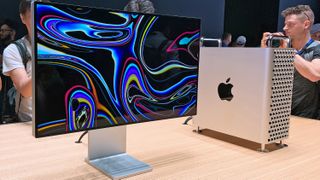
Professionals that need more horsepower than a Macbook or iMac can provide have been waiting for years to get a great replacement to the Mac Pro. As high-performance users have clamored for more powerful processors and upgradeable graphics, Apple's failure to support this sort of upgradability has been a huge source of frustration for a lot of power users.
The new Mac Pro should fix all of that, with a stunning new modular design, upgradeable graphics hardware, and a companion 6K monitor that might just be the best display ever. But it's not all praise and longing for the powerful Mac Pro. The desktop's base price barely scratches the surface when compared to configurations that cost tens of thousands of dollars, and the display has people pretty riled up with it's sold-separately stand.
- More: Stay safe online with the best Mac VPN
Mac Pro price and release date
The pple Mac Pro is available now from Apple, starting at $5,999.
The starting price for the Mac Pro is $5,999. That model will have an 8-core Intel Xeon processor, 32GB of memory, Radeon Pro 580X graphics and a 256GB solid-state drive for storage.
Higher end configurations are available, scaling up to dizzying heights. The max configuration available now boasts a 28-core Intel Xeon W processor, 1.5TB of memory, dual AMD Pro Vega II Duo graphics cards, a discrete Afterburner video processing card and 4TB of SSD storage. While early estimates speculated that thius top configuration might cost as much as $35,000, the actuial cost for this configuration is a blistering $52,199.
Mac Pro Tech Specs
| Row 0 - Cell 0 | Base Specs | Top Specs |
| Price | $5,999 | $52,199 |
| CPU | Intel Xeon W8 Cores, 3.5GHz | Intel Xeon W28 Cores, 2.5GHz |
| Memory | 32GBFour 8GB DIMMs | 1.5TB12 128GB DIMMs |
| Graphics | AMD Radeon Pro 580X | 2x AMD Radeon Pro Vega II Duo |
| Video Processing Hardware | none | AfterburnerProRes and ProRes RAW accelerator card |
| Storage | 256GB SSD | 4TB SSD |
Sleek new looks
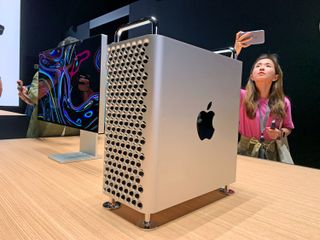
The new Mac Pro gets a major redesign, ditching the all-in-one stylings of the iMac Pro and moving past the cylindrical design of the 2013 Mac Pro. The new design calls back to the older Mac Pros from the early aughts, with a tower design made of stainless steel, and a machined lattice front on the tower offering plenty of airflow for the tower's three internal cooling fans.
Sign up to get the BEST of Tom's Guide direct to your inbox.
Get instant access to breaking news, the hottest reviews, great deals and helpful tips.
The tower design is distinctive, thanks in part to the chunky steel handles on top and feet on the bottom, raising the Mac Pro a good inch or so off of your desktop surface. And if you want to set the Mac Pro on the floor, but still be able to easily move the tower, you can attach optional wheels.
Crazy power inside
But the most drastic changes are under the hood, with an upgradeable, expandable design that will let users not only access all of the internals – something the 2018 iMac Pro didn't do – and providing room for upgrades and configuration changes, which were difficult (and sometimes outright impossible) on the compact Mac Pro 2013.
The new Mac Pro boasts PCI expansion, and a lot of it, with 8 internal PCI slots, including four double-wide slots, three single-width slots, and a half-width PCI slot that is used for I/O ports. The port selection includes two Thunderbolt 3 ports, two USB 3.0 ports, a dual 10-Gigabit Ethernet ports.
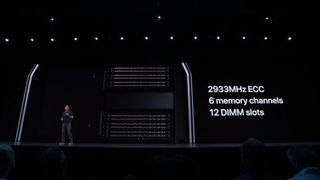
The hardware specs range from reasonable to insane, starting with an 8-core Intel Xeon processor, but scaling up to a massive 28-core Xeon in top configurations. This is supported with 300-watts of power for the processor alone, and a giant heat-sink that ensures the CPU will stay cool without throttling performance.
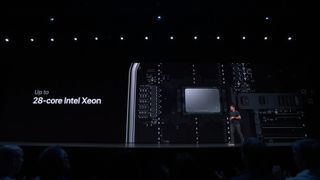
Memory support goes even farther, with 6 channels of 2933MHz ECC memory and 12 DIMM slots, letting you outfit the Mac Pro with a mind-boggling 1.5 terabyte of RAM. (That's not a typo).
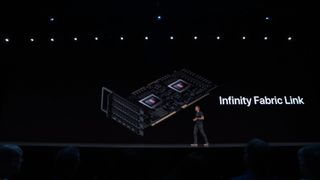
Graphics support is similarly outsized, with Apple introducing a new graphics module that combines a 16x PCIe connection, ports for DisplayPort and power, and a giant fanless heatsink, all combining into what Apple calls the MPX Module. These modules can be configured to support a basic AMD Radeon Pro 580x card, a single AMD Radeon Pro Vega II card, or two Radeon Pro Vega II cards running in tandem. And the Mac Pro will support two MPX modules, potentially letting you outfit one Mac Pro with four Radeon Pro Vega II cards for unprecedented graphics power.
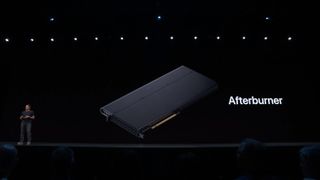
To enhance video processing – a major boon to video pros – Apple is also adding the option of a custom hardware accelerator called Afterburner. Designed exclusively with video processing in mind, Apple says Afterburner will support up to three simultaneous streams of ProRes raw footage at 8K resolution. At 4K resolution, it can handle 12 streams, pushing up to 6 billion pixels per second.
All of this is powered by a giant 1.4 kilowatt power supply, and cooled with a trio of fans that pull cool air in through the front of the tower and exhaust out the back.
Apple Pro Display XDR: A 6K monitor to match

The Mac Pro is definitely the most powerful desktop Apple has ever made, but the new monitor designed to accompany it is just as impressive. The Pro Display XDR is a 32-inch monitor with a spec list that should make video professionals drool: 6K resolution, incredible High-Dynamic Range support, and both 10-bit color and P3 Wide color gamut.
The Pro Display XDR will begin selling this fall alongside the Mac Pro. The standard model will sell for $4,999, with the matte-finish option selling for $5,999.
The Pro Display XDR's physical design matches the new Mac Pro, with a machined aluminum chassis that serves as a giant heatsink for the internal components. With full-array backlight and tightly focused local dimming, Apple promises that the monitor has a peak brightness of 1,600 nits, with the capability of displaying 1,000 nit of sustained brightness uninterrupted for as long as you need it. In true Apple fashion, the company decided this was worthy of branding, and are calling it Extreme Dynamic Range (XDR).
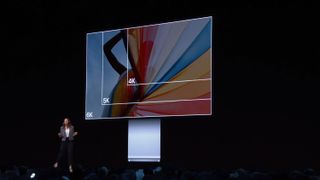
The display is factory calibrated, and features super wide viewing angles, a specialized polarizing filter that maintains off-angle color quality, and a glare-reducing glass surface with an optional matte finish. That matte finish isn't just an extra glare-reducing coating, it's a nanoscale etching into the surface of the glass, which should stave off reflections and glare and never wear off.
The Pro Display XDR connects with Thunderbolt 3, and using Thunderbolt's daisy-chain capability, Apple says that you can connect as many as 6 of the new displays at once.
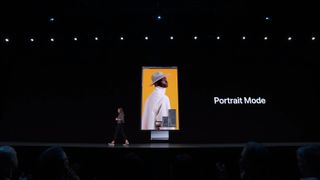
We had a chance to see the Pro Display XDR in action against some of the best screens on the market, including a reference OLED panel from Sony that costs over $20,000, and the iPad delivered a brighter image with even more accurate colors. This is an amazing display period.
The monitor sits on a beefy L-shaped stand ($999) with a dual-hinge design so that you can adjust the height and angle. It's also rotatable, providing a portrait mode for the first time on an official Mac display. For other mounting options, there is a quick attach VESA mounting bracket ($199) that will let you hang the monitor on the wall or attach a more flexible mounting arm.
That thousand dollar price tag on the stand has even the Apple faithful up in arms. While Apple waxed poetic about the stand's dual-hinge adjustable design, all-metal construction and counterbalanced weighting that makes positioning the monitor almost effortless, others balked at the fact that the stand wasn't included. Given the Pro Display XDR's $4,999 price tag, it's jarring to hear that there's no stand in the box, and even more upsetting when you consider that the stand costs more than an iPhone X ($749), a device already derided as unnecessarily expensive.
Brian Westover is currently Lead Analyst, PCs and Hardware at PCMag. Until recently, however, he was Senior Editor at Tom's Guide, where he led the site's TV coverage for several years, reviewing scores of sets and writing about everything from 8K to HDR to HDMI 2.1. He also put his computing knowledge to good use by reviewing many PCs and Mac devices, and also led our router and home networking coverage. Prior to joining Tom's Guide, he wrote for TopTenReviews and PCMag.
